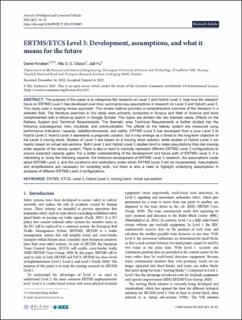| dc.contributor.author | Knutsen, Daniel | |
| dc.contributor.author | Olsson, Nils Olof Emanuel | |
| dc.contributor.author | Fu, Jiali | |
| dc.date.accessioned | 2023-11-08T08:39:50Z | |
| dc.date.available | 2023-11-08T08:39:50Z | |
| dc.date.created | 2023-09-13T14:47:52Z | |
| dc.date.issued | 2023 | |
| dc.identifier.citation | Journal of Intelligent and Connected Vehicles (JICV). 2023, 6 (1), 34-45. | en_US |
| dc.identifier.issn | 2399-9802 | |
| dc.identifier.uri | https://hdl.handle.net/11250/3101286 | |
| dc.description.abstract | The purpose of this paper is to categorize the research on Level 3 and Hybrid Level 3; map how the research focus on ERTMS Level 3 has developed over time; summarize key assumptions in research on Level 3 and Hybrid Level 3. This study uses a scoping review approach. This review method provides a comprehensive overview of the literature in a selected field. The literature searches in this study were primarily conducted in Scopus and Web of Science and were complemented with a follow-up search in Google Scholar. The topics are divided into two thematic areas: Effects on the Railway System and Technical Requirements. The thematic area Technical Requirements is further divided into the following subcategories: train, trackside, and communication. The effects on the railway system are measured using performance indicators: capacity, stability/robustness, and safety. ERTMS Level 3 has developed from a pure Level 3 to Hybrid Level 3. Hybrid Level 3 represents a pragmatic solution, but it may emerge as a threat to the long-term objective of the Level 3 moving block. Studies of Level 3 are based on a moving block solution, while studies of Hybrid Level 3 are mainly based on virtual sub-sections. Both Level 3 and Hybrid Level 3 studies tend to make assumptions that risk missing wider aspects of the railway system. There is also a need to correctly represent different ERTMS Level 3 configurations to ensure expected capacity gains. For a better understanding of the development and future path of ERTMS Level 3, it is interesting to study the following aspects: the historical development of ERTMS Level 3 research, the assumptions made about ERTMS Level 3, and the conditions and restrictions under which ERTMS Level 3 will be implemented. Assumptions and simplifications are necessary for modeling work, but there is also a need to highlight underlying assumptions in analyses of different ERTMS Level 3 configurations. | en_US |
| dc.language.iso | eng | en_US |
| dc.publisher | IEEE | en_US |
| dc.rights | Navngivelse 4.0 Internasjonal | * |
| dc.rights.uri | http://creativecommons.org/licenses/by/4.0/deed.no | * |
| dc.title | ERTMS/ETCS Level 3: Development, assumptions, and what it means for the future | en_US |
| dc.title.alternative | ERTMS/ETCS Level 3: Development, assumptions, and what it means for the future | en_US |
| dc.type | Peer reviewed | en_US |
| dc.type | Journal article | en_US |
| dc.description.version | publishedVersion | en_US |
| dc.source.pagenumber | 34-45 | en_US |
| dc.source.volume | 6 | en_US |
| dc.source.journal | Journal of Intelligent and Connected Vehicles (JICV) | en_US |
| dc.source.issue | 1 | en_US |
| dc.identifier.doi | 10.26599/JICV.2023.9210003 | |
| dc.identifier.cristin | 2174783 | |
| cristin.ispublished | true | |
| cristin.fulltext | preprint | |
| cristin.qualitycode | 1 | |

